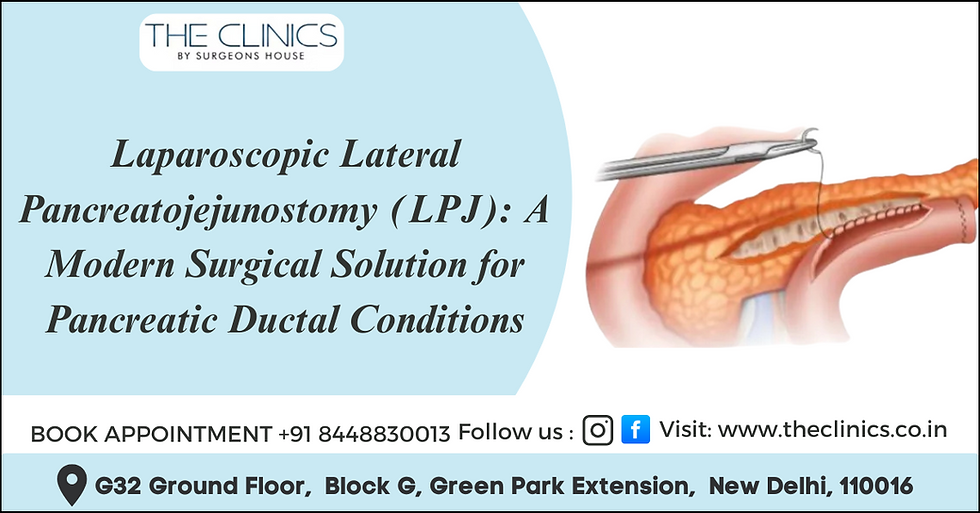Laparoscopic Lateral Pancreatojejunostomy (LPJ): A Modern Surgical Solution for Pancreatic Ductal Conditions
- Natik Sungra

- 1 day ago
- 4 min read

Many people who suffer from chronic pancreatitis or pancreatic duct blockage live with constant pain, repeated hospital visits, and difficulty in eating properly. For such patients, doctors may suggest a surgery called Laparoscopic Lateral Pancreatojejunostomy (LPJ).
This may sound like a complicated name, but the surgery itself is designed to relieve pain, improve digestion, and give patients a better quality of life. In this blog, we explain LPJ in the simplest possible way — what it is, why it is needed, how it is done, recovery, risks, and benefits.
What is the Pancreas and Why is it Important?
The pancreas is a small organ located in the upper abdomen, just behind the stomach. It has two main jobs:
Helps in digestion – by making special juices (enzymes) that break down food.
Controls blood sugar – by producing hormones like insulin.
These digestive juices travel through a tube called the pancreatic duct and mix with food in the small intestine.
What Happens When the Pancreatic Duct Gets Blocked?
Sometimes, due to chronic pancreatitis, stones, or scarring, the pancreatic duct becomes narrow or blocked. When this happens:
Digestive juices cannot flow properly.
Pressure builds up inside the pancreas.
Patients feel severe pain in the abdomen.
Food is not digested well, leading to weakness and weight loss.
This condition is called a Pancreatic Ductal Condition (PDC
What is Laparoscopic Lateral Pancreatojejunostomy (LPJ)?
LPJ is a surgical procedure where the doctor creates a new pathway for the blocked pancreatic juices.
👉 In simple words:
The doctor connects the pancreatic duct with the small intestine.
This allows the juices to flow freely.
The pressure inside the pancreas reduces.
Pain decreases, and digestion improves.
Because this is done using laparoscopy (keyhole surgery), only small cuts are made in the abdomen. This means less pain, faster recovery, and smaller scars compared to open surgery.
When Do Doctors Suggest LPJ?
Doctors may recommend LPJ if you have:
Chronic pancreatitis (long-lasting inflammation of the pancreas)
A wide pancreatic duct (usually more than 7 mm in size)
Severe abdominal pain that medicines cannot control
Repeated hospital visits due to pancreatitis
Poor digestion and loss of weight despite treatment
How is the LPJ Surgery Done?
Here is a step-by-step explanation of what happens during the surgery:
Anesthesia – You will be asleep and feel no pain during the operation.
Small cuts in the abdomen – The surgeon makes 3–4 small holes.
Camera and instruments – A thin camera (laparoscope) and special tools are inserted.
Finding the pancreatic duct – The surgeon carefully identifies the blocked or enlarged duct.
Creating a bypass – The duct is opened and connected to the small intestine.
Finishing the surgery – Instruments are removed, and cuts are closed with stitches.
The whole surgery usually takes 2–3 hours.
Benefits of LPJ Surgery
LPJ offers many advantages, especially when done laparoscopically:
✅ Long-term pain relief
✅ Better digestion and improved appetite
✅ Minimally invasive – very small cuts
✅ Shorter hospital stay – 3–5 days
✅ Faster recovery – most patients return to normal life in 2–3 weeks
✅ Smaller scars – almost invisible after healing
✅ Less blood loss and infection risk compared to open surgery
Recovery After LPJ
Most patients recover well after this surgery. Here’s what you can expect:
Day 1–2: You may start sitting, walking slowly, and sipping liquids.
Day 3–5: You can eat soft food, and most patients are discharged from the hospital.
2–3 Weeks: You can return to work or light activities.
6 Weeks: Full recovery is usually achieved.
Doctors usually advise:
Eating a low-fat, healthy diet
Avoiding alcohol and smoking
Taking prescribed medicines on time
Coming for regular follow-up checkups
Possible Risks and Complications
Like any surgery, LPJ also has some risks, though these are rare:
Infection at the site of surgery
Leakage from the new connection (anastomosis)
Bleeding
Slow emptying of the stomach (delayed gastric emptying)
When performed by an experienced surgeon, the chances of complications are very low.
Who Can Benefit Most from LPJ?
You may benefit from LPJ if you:
Have severe chronic pancreatitis pain
Have a dilated pancreatic duct visible in scans (CT, MRI, MRCP)
Cannot manage symptoms with medicines and lifestyle changes
Are otherwise fit for laparoscopic surgery
LPJ vs Open Surgery: Which is Better?
Feature | Laparoscopic LPJ | Open Surgery |
Cuts/Incisions | Small (0.5–1 cm) | Large (10–15 cm) |
Pain After Surgery | Less | More |
Hospital Stay | 3–5 days | 7–10 days |
Recovery Time | 2–3 weeks | 6–8 weeks |
Scars | Hardly visible | Big scar on abdomen |
Cost of LPJ Surgery in India
The cost of Laparoscopic LPJ in India is usually between ₹2,50,000 – ₹4,50,000, depending on:
The hospital and city
The surgeon’s experience
The patient’s overall condition
Even at this cost, India is more affordable compared to many Western countries while still offering world-class surgical care.
Why Choosing the Right Surgeon Matters
The success of LPJ depends on the skill of the surgeon. An experienced gastro and laparoscopic surgeon ensures:
A safe operation
Faster recovery
Minimal risk of complications
Better long-term results
Patients should always choose a specialized hospital or center for pancreatic surgery.
Life After LPJ Surgery
Most patients who undergo LPJ experience a big improvement in their quality of life:
Relief from constant abdominal pain
Ability to eat normally again
Improved energy and weight gain
Fewer hospital visits
Conclusion
Laparoscopic Lateral Pancreatojejunostomy (LPJ) is one of the most effective surgical treatments for patients with chronic pancreatitis and blocked pancreatic ducts. It provides lasting pain relief, better digestion, and a chance to return to normal life.
If you or your loved one has been suffering from repeated pancreatic problems, consult an experienced laparoscopic gastro surgeon to see if LPJ is the right solution.







Comments